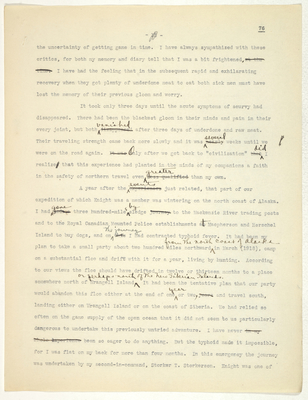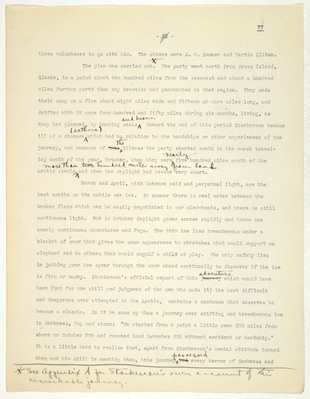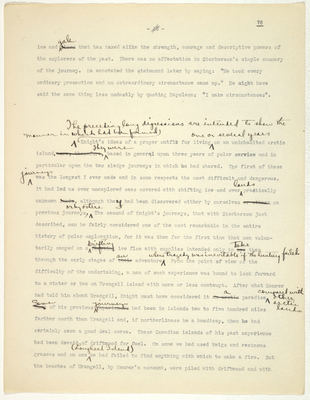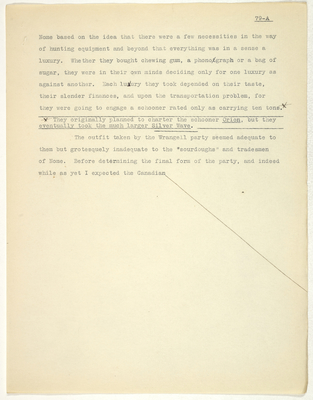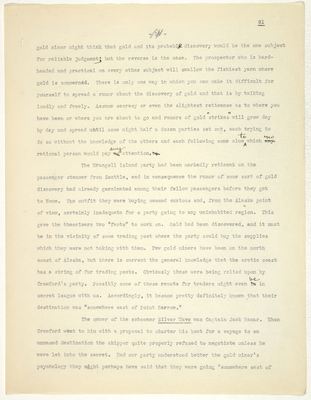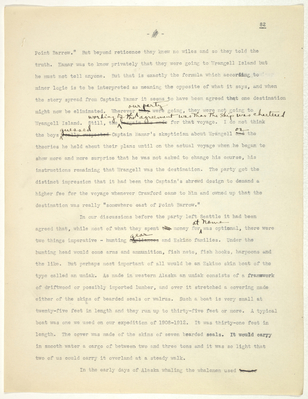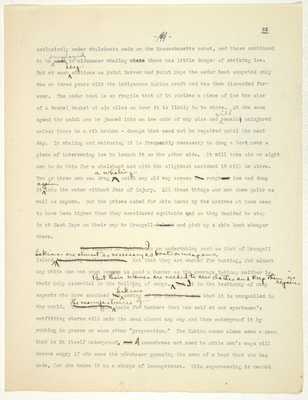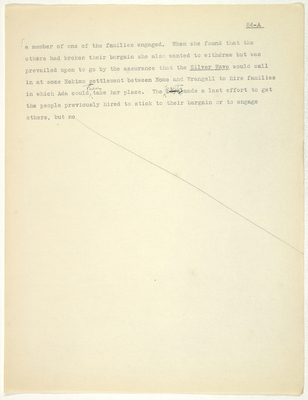Pages That Need Review
stefansson-wrangel-09-27
stefansson-wrangel-09-27-034
76
- 13 -
the uncertainty of getting game in time. I have always sympathized with these critics, for both my memory and diary tell that I was a bit frightened. at the time I have had the feeling that in the subsequent rapid and exhilarating recovery when they got plenty of underdone meat to eat both sick men must have lost the memory of their previous gloom and worry.
It took only three days until the acute symptoms of scurvy had disappeared. There had been the blackest gloom in their minds and pain in their every joint, but both, vanished disappeared after three days of underdone and raw meat. Their traveling strength came back more slowly and it was several nearly weeks until we were on the road again. It was Only after we got back to “civilization" that did I realized that this experience had planted in the minds of my companions a faith in the safety of northern travel even greater less qualified than my own.
A year after the events experiences just related, that part of our expedition of which Knight was a member was wintering on the north coast of Alaska. I had gone [adaue] three hundred-miles by sledge journey to the Mackenzie River trading posts and to the Royal Canadian Mounted Police establishments at Macpherson and Hersehel Island to buy dogs, and on the journey I had contracted typhoid fever. It had been my plan to take a small party about two hundred miles northward from the north coast of Alaska in March (1918), camp on a substantial floe and drift with it for a year, living by hunting. According to our views the floe should have drifted in twelve or thirteen months to a place somewhere north of Wrangell Island or perhaps north of the new Siberian Islands. It had been the tentative plan that our party would abandon this floe either at the end of one year or two, years and travel south, landing either on Wrange11 Island or on the coast of Siberia. We had relied so often on the game supply of the open ocean that it did not seem to us particularly dangerous to undertake this previously untried adventure. I have never in my whole experience been so eager to do anything. But the typhoid made it impossible, for I was flat on my back for more than four months. In this emergency the journey was undertaken by my second-in-command, Storker T. Storkerson. Knight was one of
stefansson-wrangel-09-27-035
77
- 14 -
three volunteers to go with him. The others were A. G. Gumaer and Martin Kilian. The plan was carried out. The party went north from Cross Island, Alaska, to a point about two hundred miles from the seacoast and about a hundred miles farther north than any traveler had penetrated in that region. They made their camp on a floe about eight miles wide and fifteen or more miles long, and drifted with it some four-hundred and fifty miles during six months, living, as they had planned by hunting seals and bears. Toward the end of this period Storkerson became ill of a disease (asthma) which had no relation to the hardships or other experiences of the journey, and because of this the illness the party started south in the worst traveling month of the year, October, when they were nearly five hundred miles north of the arctic circle, more than two hundred miles away from land and when the daylight had become very short.
March and April, with intense cold and perpetual light, are the best months on the mobile sea ice. In summer there is real water between the broken floes which can be easily negotiated in our sled-boats, and there is still continuous light. But in October daylight grows scarce rapidly and there are nearly continuous snowstorms and fogs. The thin ice lies treacherous under a blanket of snow that gives the same appearance to stretches that would support an elephant and to others that would engulf a child at play. The only safety lies in jabbing your ice spear through the snow ahead continually to discover if the ice is firm or mushy. Storkerson's official report of this journey adventure which would have been (but for the skill and judgment of the men who made it) the most difficult and dangerous ever attempted in the Arctic, contains a sentence that deserves to become a classic. In it he sums up thus a journey over shifting and treacherous ice in darkness, fog and storm: "We started from a point a little over 200 miles from shore on October 9th and reached land November 8th without accident or hardship." It is a little hard to realize that, apart from Storkerson's mental attitude toward them and his skill in meeting them, this journey possessed had terror of darkness and
*See Appendix A for Storkenson's own account of this remarkable journey.
stefansson-wrangel-09-27-036
78
- 15 -
ice and gale storm that has taxed alike the strength, courage and descriptive powers of the explorers of the past. There was no affectation in Storkerscn's simple summary of the journey. He annotated the statement later by saying: "We took every ordinary precaution and no extraordinary circumstance came up." He might have said the same thing less modestly by quoting Napoleon: ”I make circumstances".
The preceding long digressions are intended to show the manner in which had been formed. Knight's ideas of a proper outfit for living one or several years on an uninhabited arctic island. were therefore They were based in general upon three years of polar service and in particular upon the two sledge journeys in which he had shared. The first of these journeys was the longest I ever made and in some respects the most difficult and dangerous. It had led us over unexplored seas covered with shifting ice and over lands practically unknown lands although they had been discovered either by ourselves or others on previous journeys, or by others. The second of Knight1s journeys, that with Storkerson just described, can be fairly considered one of the most remarkable in the entire history of polar exploration, for it was then for the first time that men voluntarily camped on a drifting floating ice floe with supplies intended only to them see take them through the early stages of an their adventure where tragedy was inevitable if the hunting failed. From the point of view of the difficulty of the undertaking, a man of such experience was bound to look forward to a winter or two on Wrangell Island with more or less contempt. After what Maurer had told him about Wrangell, Knight must have considered it an arctic a paradise compared with other arcitc lands. Many Some of his previous experiences journeys had been in islands two to five hundred miles farther north than Wrangell and, if northerliness be a handicap, then he had certainly seen a good deal worse. These Canadian islands of his past experience had been devoid of driftwood for fuel. On some we had used twigs and resinous grasses and on one (Lougheed Island) we had failed to find anything with which to make a fire. But the beaches of Wrangell, by Maurer's account, were piled with driftwood and with
stefansson-wrangel-09-27-037
long, straight logs suitable for the building of cabins to be heated with open fires or stoves.
Moreover, Knight had already traveled through a region where for two successive years we had never seen the track of a polar bear, but Maurer told of the bears on Wrangell going by towe two and threes and half dozens, the beach trampled down with their tracks. Against the scarcity of birds and nests where Knight had been in Meighen and the Ringnes Islands, there were seabird rookeries at Wrangell and tens of thousands of geese and other birds flying in clouds. He had been ill more than five hundred miles from the nearest human beings with less than half rations for a week on hand, and it seemed to him in looking back that he had not worried even then. Now when he looked forward to probable good health on Wrangell Island, less than a hundred miles away from the hospitable American and Russian traders and the wealthy and equally hospitable natives of northern Siberia, it seemed to him that a shipload of goods would be almost a superfluity and that he could land with a sledge and a team of dogs on Wrangell an outfit that would keep him safer and more comfortable than he had been used to being on his former expedition. Indeed, it had been his plan and Storkerson's on their trip in 1918 to land on Wrangell if they had drifted that far west. Their outfit then would have been two sledges empty except for cooking gear, ammunition, old clothes and a few scientific instruments. With such an outfit they had planned to land on Wrangell in May, spend the summer there and proceed to Siberia the following January. To men of the experience of Storkerson and Knight, this would seem easier and safer than several journeys in which they had already taken part.
With Maurer's experience of Wrangell Island and the theories he and Knight held in common, it was logical for Crawford to do what we had agreed he should do and to buy an outfit both in Seattle and
stefansson-wrangel-09-27-038
79-A
Nome based, on the idea that there were a few necessities in the way of hunting equipment and beyond that everything was in a sense a luxury. Whether they bought chewing gum, a phonograph or a bag of sugar, they were in their own minds deciding only for one luxury as against another. Each luxury they took depended on their taste, their slender finances, and upon the transportation problem, for they were going to engage a schooner rated only as carrying ten tons.*
-------------------------------------------------------------------------------------------------------------- *They originaliy planned to charter the schooner Orion, but they eventually took the much larger Silver Wave. --------------------------------------------------------------------------------------------------------------
The outfit taken by the Wrangell party seemed adequate to them but grotesquely inadequate to the "sourdoughs" and tradesmen of Nome. Before determining the final form of the party, and indeed while as yet I expected the Canadian
stefansson-wrangel-09-27-040
81
- 19 -
gold miner might think that gold and its probable discovery would be the one subject for reliable judgment; but the reverse is the case. The prospector who is hardheaded and practical on every other subject will swallow the fishiest yarn where gold is concerned. There is only one way in which you can make it difficult for yourself to spread a rumor about the discovery of gold and that is by talking loudly and freely. Assume secrecy or even the slightest reticence as to where you have been or where you are about to go and rumors of gold "strikes" will grow day by day and spread until some night half a dozen parties set out, each trying to do so without the knowledge of the others and each following some clue to which no rational person would pay any attention.
The Wrangell Island party had been markedly reticent on the passenger steamer from Seattle, and in consequence the rumor of some sort of gold discovery had already germinated among their fellow passengers before they got to Nome. The outfit they were buying seemed curious and, from the Alaska point of view, certainly inadequate for a party going to any uninhabited region. This gave the theorisers two '’facts" to work on. Gold had been discovered, and it must be in the vicinity of some trading post where the party could buy the supplies which they were net taking with them. Few gold miners have been on the north coast of Alaska, but there is current the general knowledge that the arctic coast has a string of fur trading posts. Obviously these were being relied upon by Crawford's party. Possibly some of these remote fur traders might even be, in secret league with us. Accordingly, it became pretty definitely known that their destination was "somewhere east of Point Barrow."
The owner of the schooner Silver Wave was Captain Jack Hamar. When Crawford went to him with a proposal to charter his boat for a voyage to an unnamed destination the skipper quite properly refused to negotiate unless he were let into the secret. Had our party understood better the gold miner's psychology they might perhaps have said that they were going "somewhere east of
stefansson-wrangel-09-27-041
82
- 18 -
Point Barrow.” But beyond reticence they knew no wiles and so they told the truth. Hamar was to know privately that they were going to Wrangell Island but he must not tell anyone. But that is exactly the formula which according to miner logic is to be interpreted as meaning the opposite of what it says, and when the story spread from Captain Hamar it seems to have been agreed that one destination might now be eliminated. Wherever our party they were going, they were not going to Wrangell Island. Still, the working of the agreement was that the ship was chartered bargain was made for that voyage. I do not think the boys guessed really suspected Captain Hamar's skepticism about Wrangell and or the theories he held about their plans until on the actual voyage when he began to show more and more surprise that he was not asked to change his course, his instructions remaining that Wrangell was the destination. The party got the distinct impression that it had been the Captain's shrewd design to demand a higher fee for the voyage whenever Crawford came to him and owned up that the destination was really "somewhere east of Point Barrow."
In our discussions before the party left Seattle it had been agreed that, while most of what they spent the money for at Nome was optional, there were two things imperative - hunting appliances gear and Eskimo families. Under the hunting head would come arms and ammunition, fish nets, fish hooks, harpoons and the like. But perhaps most important of all would be an Eskimo skin boat of the type called an umiak. As made in western Alaska an umiak consists of a framework of driftwood or possibly imported lumber, and over it stretched a covering made either of the skins of bearded seals or walrus. Such a boat is very small at twenty-five feet in length and they run up to thirty-five feet or more. A typical boat was one we used on our expedition of 1908-1912. It was thirty-one feet in length. The cover was made of the skins of seven bearded seals. It would carry in smooth water a cargo of between two and three tons and it was so light that two of us could carry it overland at a steady walk.
In the early days of Alaska whaling the whalemen used to use
stefansson-wrangel-09-27-042
83
- 20 -
exclusively cedar whaleboats made on the Massachusetts coast, and these continued to be employed used in midsummer whaling where there was little danger of striking ice. But at such icy stations as Point Barrow and Point Hope the cedar boat competed only two or three years with the indigenous Eskimo craft and was then discarded forever. The cedar boat is so fragile that if it strikes a piece of ice the size of a bushel basket at six miles an hour it is likely to be stove. At the same speed the umiak can be jammed into an ice cake of any size and will remains uninjured unless there be a rib broken - damage that need not be repaired until the next day. In whaling and walrusing it is frequently necessary to drag a boat over a piece of intervening ice to launch it on the other side. It will take six or eight men to do this for a whaleboat and with the slightest accident it will be stove. Two or three men can drag an a whaling umiak any old way across the roughed ice and dump it again into the water without fear of injury. All these things our men knew quite as well as anyone. But the prices asked for skin boats by the natives at Nome seem to have been higher than they considered equitable and so they decided to stop in at East Cape on their way to Wrangell Island and pick up a skin boat cheaper there.
The support of Eskimos In an undertaking such as that of Wrangell Island, Eskimos are almost as neccesary as boats or weapons.is nearly indispensable Not that they are wanted for hunting, for almost any white man can soon become as good a hunter as tha average Eskimo; neither is their help essential in the building of camps. But their women are needed to sew clothes and keep them in repair. But It is the testimony of many experts who have examined the Eskimos sewing of the Eskimo women that it is unequalled in the world. Those who make The manufacturers of boots for hunters that are sold at our sportsmen’s outfitting stores will make the seam almost any way and then waterproof it by rubbing in grease or some other "preparation." The Eskimo woman alone sews a seam that is in itself waterproof. and A seamstress not used to white men's ways will become angry if she sees the purchaser greasing the seam of a boot that she has made, for she takes it as a charge of incompetence. This super-sewing is needed
stefansson-wrangel-09-27-043
84
only for skin boats and waterproof sealskin boots. But there is another sewing almost as difficult to acquire and almost as necessary - that of the warm, soft and pliable skin clothes that keep out the winter cold. It is possible to dress in silk, cotton or woolen clothing if one wants to follow such methods as hare been used in the Antarctic by Scott and Shackle ton. But no one will do that if he has the chance of Eskimo clothing, for it is apparently not possible to be thoroughly comfortable at all in the antarctic clothing and the suits actually used have weighed about doubl.* The best sort of Eskimo suit, complete with outer and
------------------------------------------------------------------------------------------------------ For a description of the troubles of polar explorers who did not use Eskimo clothes, or who did not understand how clothes can be kept dry in winter, see Nansen, "Farthest North," Vol. II. pp. 142, 145-6, and Shackleton, "Heart of the Antarctic" Vol. I, p. 340. A summary of the difficulties of explorers with their winter clothing and of the modern methods for avoiding them is also found in "The Friendly Arctic-" see index of this book. __________________________________________________________
inner garments from top to toe, will weigh about ten pounds where a corresponding antarctic outfit of wool, silk and Burberry goes to twenty or more pounds.
It is impractical under ordinary circumstances to take Eskimos on expeditions otherwise than in entire families. Almost any Eskimo man might be willing to engage himself for a year’s job in a mining camp or on a whaling ship, relying, perhaps somewhat reluctantly, upon European or American clothes. But for a readence in an island like Wrangell it would be almost impossible to engage an Eskimo man unless he knew that there would be womenalong to do suitable sewing.
With these ideas clearly in mind the Wrangell party tried to engage at Nome some Eskimo XEttismaKfc families, and did so actually. But when the time came to sail there arrived at the boat landing only the Eskimo woman Ada Blackjack, who had been expecting to go along as
stefansson-wrangel-09-27-044
84-A
a member of one of the families engaged. When she found that the others had broken their bargain she also wanted to withdraw but was prevailed upon to go by the assurance that the Silver Wave would call in at some Eskimo settlement between Home and Wrangell to hire families in which Ada could then take her place. The entry made a last effort to get the people previously hired to stick to their bargain or to engage others, but no
